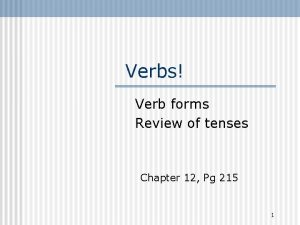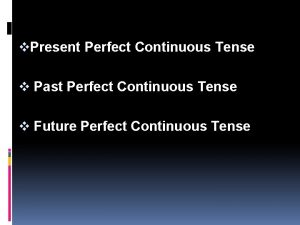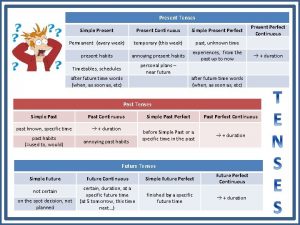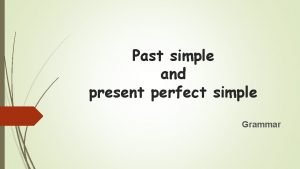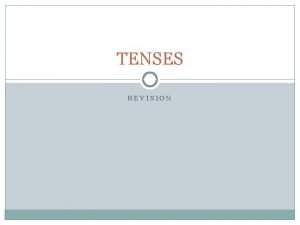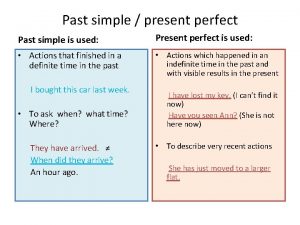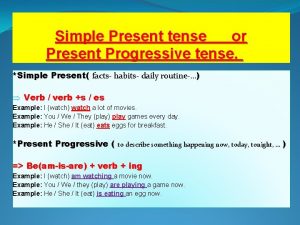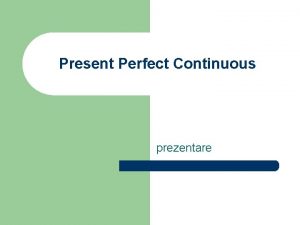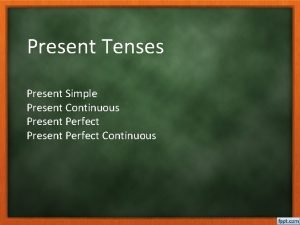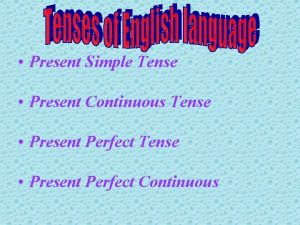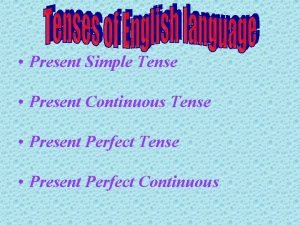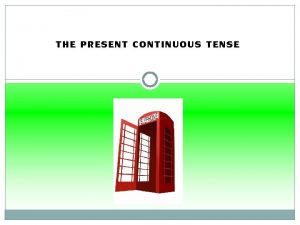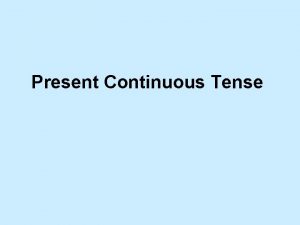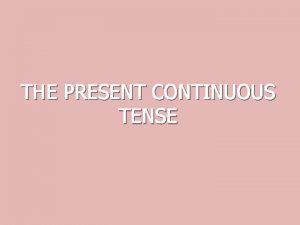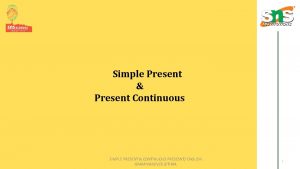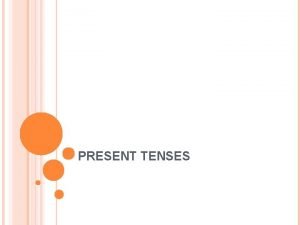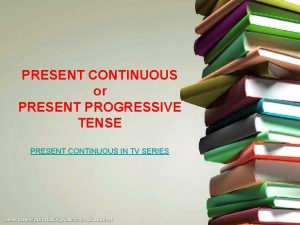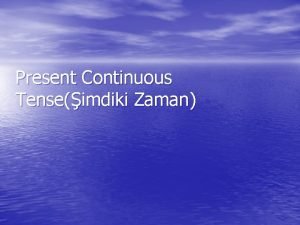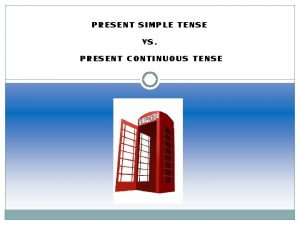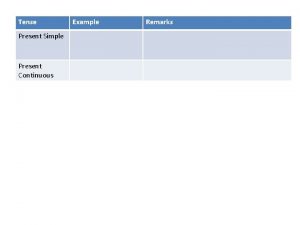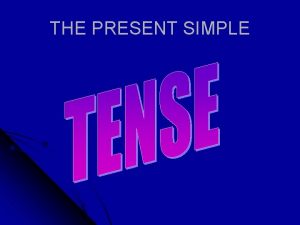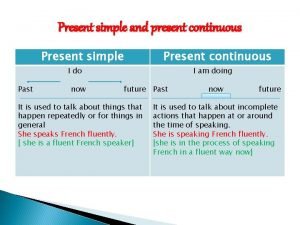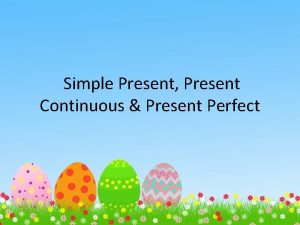Simple Present Present Continuous Tense Simple Present Tense

























- Slides: 25

Simple Present & Present Continuous Tense

Simple Present Tense Prosto sadašnje vreme Ø • • l l l • Gradi se od osnovnog oblika glagola (infinitiv bez ”to”, npr. buy, sell, work. . . ) • Treće lice jednine – dodaje se –s/es • Potvrdni oblik: I speak English We speak English You speak English He/she/it speaks English They speak English

Nastavak za treće lice jednine može biti -s ili -es l l l l • Ako se glagol završava na –o dodaje se –es, go – goes; do – does • Ako se glagol završava na –ch, -sh, -x, -ss, dodaje se takođe –es watch- watches; wash-washes; kiss-kisses; fix-fixes • Ako se glagol završava na –y a ispred njega je suglasnik, -y prelazi u –ies (cry -cries, fly-flies), ali ako je ispred -y samoglasnik, nema promene (buy-buys, play-plays) • Glagol HAVE u 3 l. j. glasi HAS

Upitni oblik • Upitni oblik gradi se od pomoćnog glagola ”do” , odnosno ”does”(za 3 l. j. ) l Do I speak English? l Do you speak English? l Does he/she/it speak English? l l Do we speak English? Do you speak English? Do they speak English?

Odrični oblik • Odrični oblik se gradi od odričnog oblika pomoćnog glagola ”do”, odnosno ”does” (za 3 l. j. ) l I do not (don’t) speak English. l You do not (don’t) speak English. l He/she/it does not (doesn’t) speak English. l l We do not (don’t) speak English. You do not (don’t) speak English. They do not (don’t) speak English.

Upotreba 1 Radnja koja se ponavlja Prosto sadašnje vreme se koristi za radnju koja se ponavlja ili je uobičajna (navika, hobi, svakodnevni događaj, rutine, običaji ili nešto se često dešava). To takođe može biti nešto osoba često zaboravlja ili obično ne učini. Primeri: • She gets up at 6 o’clock every morning. • She does not play tennis every day. • We never eat in the living room. • She wears uniform at work.

Upotreba 2 Činjenice ili generalizacija Prosto sadašnje vreme takođe se koristi kada govornik smatra da nešto predstavlja opštu činjenicu ili nešto je uvek tačno. Takođe se koristi za generalizacije o ljudima ili stvarima. Primeri: • Cats like milk. • A dog is a faithful animal. • Water boils at 100 degrees C. • California is in America.

Upotreba 3 Zakazani događaji u bliskoj budućnosti Prosto sadašnje vreme se nekada koristi i kada govorimo o zakazanim događajima u bliskoj budućnosti, najčešće kada govorimo o javnom prevozu. Primeri: • The train leaves tonight at 6 PM. • The bus does not arrive at 11 AM, it arrives at 11 PM. • When do we board the plane? • The party starts at 8 o'clock.

Upotreba 4 Sada (”Non-Continuous”glagoli) Prosto sadašnje vreme se nekada koristi za radnju koja se dešava ili se ne dešava sada (u trenutku govora), ali samo u slučaju kada upotrebljavamo ”non-continuous” glagole. Primeri: • I am here now. • She is not here now. • He needs help right now. • He does not need help now.

”Non-continuous” glagoli su glagoli koji se ne koriste u trajnim (continuous) vremenima, kao što je Present Continuous Tense. Ovi glagoli se odnose na stanje a ne na radnju i ne mogu se koristiti u trajnim vremenima, čak i ako se to stanje odvija u trenutku govora što je osnovna upotreba vremena Present Continuous Tense. Neki od najčešćih glagola stanja su: Ø osećanja: hate, like, love, prefer, want, wish Ø čula: appear, feel, hear, seem, smell, sound, taste Ø komunikacija: agree, deny, disagree, mean, promise, satisfy, surprise Ø razmišljanje: believe, imagine, know, mean, realize, recognize, remember, understand Ø ostala stanja: be, belong, concern, depend, involve, matter, need, owe, own, possess Ø Primeri: • She needs help. Not : She is needing help. • He wants a break. Not : He is wanting a break.

Priloške odredbe za Prosto sadašnje vreme l § o o o Priloške odredbe koje se koriste za Prosto sadašnje vreme su: • always • every day • often • every month • usually • every year • sometimes • twice a week • seldom • three times a year • never • on Mondays

Present Continuous Tense Sadašnje trajno vreme • Sadašnje trajno vreme se gradi od glagola ”to be” u Prostom sadašnjem vremenu (am/are/is) + Present Participle (Sadašnji particip) glavnog glagola (glagol+ing) • Sadašnji particip se gradi kada se na infinitiv doda nastavak -ing: work-working; listen-listening; sell- selling • Ako se glagol završava na suglasnik ispred kojeg stoji kratak, nenaglašen samoglasnik, krajnji suglasnik se ispred –ing udvostručava: stop-stopping; hit-hitting; begin-beginning • Ako se glagol završava na –e, ono se gubi ispred –ing: make-making; have-having; take-taking • Krajnje –l se udvostručava: travel-travelling • Ako se glagol završava na –ie, ono prelazi u –y ispred –ing: lie-lying

Potvrdni oblik I am watching TV now. l You are watching TV now. l He/she/it is watching TV now. l We are watching TV now. l You are watching TV now. l They are watching TV now. l

Upitni oblik Am I watching TV now? l Are you watching TV now? l Is he/she/it watching TV now? l Are we watching TV now? l Are you watching TV now? l Are they watching TV now? l

Odrični oblik l l l l • Odrični oblik se gradi od odričnog oblika pomoćnog glagola ”to be” u sadašnjem vremenu + Present Participle glavnog glagola I am not (I’m not) watching TV now. You are not (aren’t) watching TV now. He/she/it is not (isn’t) watching TV now. We are not (aren’t) watching TV now. You are not (aren’t) watching TV now. They are not (aren’t) watching TV now.

Upotreba 1 Sada (Now) Sadašnje trajno vreme se koristi za radnju koja se dešava u trenutku govora, sada. Takođe se koristi da se kaže da se nešto ne dešava sada, ovog momenta (negacija). Primeri: • You are learning English now. • You are not swimming now. • Are you sleeping? • I am sitting.

Use 2 Radnja koja traje i koja je u toku u trenutku govora U engleskom jeziku, „sada” može da znači: ove sekunde, danas, ovog meseca, ove godine, ovog veka, i sl. Ponekad koristimo sadašnje trajno vreme kada govorimo o radnji koja traje i koja je u toku u trenutku govora, međutim, možda se ta radnja ne dešava baš ovog trenutka. Primeri: (Sve ove rečenice mogu biti izgovorene dok jedete u restoranu. ) • I am studying to become a doctor. • I am not studying to become a dentist. • I am reading the book Tom Sawyer. • I am not reading any books right now.

Upotreba 3 Bliska budućnost Ponekad se Sadašnje trajno vreme koristi kako bi se pokazalo da će se nešto desiti, ili da se neće desiti u bliskoj budućnosti. Koristi se takođe i za planove vezane za blisku budućnost. Primeri: • I am meeting some friends after work. • I am not going to the party tonight. • Is he visiting his parents next weekend? • Isn't he coming with us tonight?

Upotreba 4 Ponavljanje i iritacija sa priloškom odredbom „always" Još jedna česta upotreba Sadašnjeg trajnog vremena je kada želimo da pokažemo da nas nešto nervira, iritira, a stalno se ponavlja (priloške odredbe koje tada koristimo su ”always” i ”constantly”). Značenje je kao kod sadašnjeg prostog vremena ali samo sa negativnom emocijom. Zapamtite da reči "always" ili "constantly" uvek stoje između pomoćnog glagola "be" i glavnog glagola sa nastavkom -ing. Primeri: • She is always coming to class late! • He is constantly talking. I wish he would shut up. • I don't like them because they are always complaining.

Priloške odredbe za Sadašnje trajno vreme l l l l Priloške odredbe za vreme koje se najčešće javljaju u ovom vremenu su: • now • this week • today • this month • at the moment • this morning • right now • Look! • Listen!

Exercises: I Put the verbs into the correct form of Present Simple: q I ( like) like lemonade very much. q We (to have) have a nice garden. q The girls always ( listen) listen to pop music. q Mr Smith (teach) teaches Spanish and French. q He often (do) does his homework after school. q She (to be) is six years old. q Simon (to have) has two rabbits and five goldfish. q Janet never (wear) wears jeans.

II Complete the sentences with the Present Continuous form of the verb in brackets: q q q q □ My sister is watching (watch) TV right now. □ The boys are not/aren’t playing (not play) tennis today. □ I am writing (write) in my notebook at the moment. □ The women are sitting (sit) in the park now. □ Dad is not/isn’t washing (not wash) his car today. □ They are driving (drive) to work right now. □ Jason is studying (study) music this year. □ The children are not/aren’t swimming (not swim) at the moment.

III Complete the sentences (Simple Present or Present Continuous): q This (be) is Peter. q He (wear) is wearing a t-shirt and shorts today. q He (eat) is eating an apple at the moment. q Peter (like) likes fruits and vegetables. q He (eat) eats some every day. q Peter (know) knows that apples (be) are good for his health. q He does not/doesn’t like answering too many questions. (not like)

IV Use the verbs in brackets in the correct tenses – Simple Present or Present Continuous: q The train leaves at 11: 45. (to leave) q We are having dinner at a nice restaurant on Saturday. (to have) q I am meeting her best friend on Sunday. (to meet) q They are flying to London on Friday evening. (to fly) q The English lesson begins at 8: 45. (to begin) q I am seeing my sister in April. (to see) q What time does the concert start? (to start) q The shop opens at 8: 00 a. m. (to open) q He is always coming late!(to come)

V Present Tense – Simple or Continuous l l l l l 1. They normally have lunch at two. (have) 2. Are you working in Paris this week? (you work) 3. What do you do for a living? (you do)What are you doing now? (you do) 4. I played football at school but now I prefer swimming (prefer) 5. I have no idea what the book is about. Can you tell me what it’s about? (have) 6. John is having a difficult time at the university this year (have) 7. My father knows everything about cars, but nothing about bicycles. (know) 8. The moon goes round the earth. (go) 9. Do you see those men at the door? – They are looking at us very strangely (you see, look) 10. We feel that the contents of this letter should be changed. (feel)
 Past future tense adalah
Past future tense adalah What is past future continuous tense
What is past future continuous tense Verb to be in present continuous
Verb to be in present continuous Present continuous tense examples in hindi
Present continuous tense examples in hindi Past progressive practice
Past progressive practice Past continuous present simple
Past continuous present simple Past simple future simple present simple
Past simple future simple present simple Simple present simple past simple future exercises
Simple present simple past simple future exercises Present continuous present simple exercises
Present continuous present simple exercises Past simple and past continuous past perfect
Past simple and past continuous past perfect Present perfect continuous irregular verbs
Present perfect continuous irregular verbs Present perfect tense vs present perfect continuous tense
Present perfect tense vs present perfect continuous tense Verb tense review
Verb tense review Present simple примеры
Present simple примеры Simple past continuous tense examples
Simple past continuous tense examples Present perfect continuous auxiliary verb
Present perfect continuous auxiliary verb Present continuous tense
Present continuous tense Signaal woorden past simple
Signaal woorden past simple Revision present simple
Revision present simple Present simple present continuous past simple
Present simple present continuous past simple Present simple present continuous or past simple
Present simple present continuous or past simple Simple present and present progressive tense
Simple present and present progressive tense I write a letter now past continuous tense
I write a letter now past continuous tense Present perfect simple vs present perfect continuous
Present perfect simple vs present perfect continuous Schema present perfect continuous
Schema present perfect continuous Present simple present continuous present perfect
Present simple present continuous present perfect












